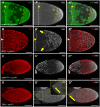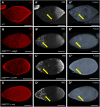The ETS-transcription factor Pointed is sufficient to regulate the posterior fate of the follicular epithelium
- PMID: 33028611
- PMCID: PMC7687869
- DOI: 10.1242/dev.189787
The ETS-transcription factor Pointed is sufficient to regulate the posterior fate of the follicular epithelium
Abstract
The Janus-kinase/signal transducer and activator of transcription (JAK/STAT) pathway regulates the anterior posterior axis of the Drosophila follicle cells. In the anterior, it activates the bone morphogenetic protein (BMP) signaling pathway through expression of the BMP ligand decapentaplegic (dpp). In the posterior, JAK/STAT works with the epidermal growth factor receptor (EGFR) pathway to express the T-box transcription factor midline (mid). Although MID is necessary for establishing the posterior fate of the egg chamber, we show that it is not sufficient to determine a posterior fate. The ETS-transcription factor pointed (pnt) is expressed in an overlapping domain to mid in the follicle cells. This study shows that pnt is upstream of mid and that it is sufficient to induce a posterior fate in the anterior end, which is characterized by the induction of mid, the prevention of the stretched cells formation and the abrogation of border cell migration. We demonstrate that the anterior BMP signaling is abolished by PNT through dpp repression. However, ectopic DPP cannot rescue the anterior fate formation, suggesting additional targets of PNT participate in the posterior fate determination.
Keywords: Anterior-posterior axis coordination; Cell morphogenesis; EGFR signaling; ETS-transcription factor.
© 2020. Published by The Company of Biologists Ltd.
Conflict of interest statement
Competing interestsThe authors declare no competing or financial interests.
Figures




Similar articles
-
ETS transcription factors regulate precise matrix metalloproteinase expression and follicle rupture in Drosophila.Development. 2024 Mar 1;151(5):dev202276. doi: 10.1242/dev.202276. Epub 2024 Feb 28. Development. 2024. PMID: 38345299 Free PMC article.
-
A Hox complex activates and potentiates the Epidermal Growth Factor signaling pathway to specify Drosophila oenocytes.PLoS Genet. 2017 Jul 17;13(7):e1006910. doi: 10.1371/journal.pgen.1006910. eCollection 2017 Jul. PLoS Genet. 2017. PMID: 28715417 Free PMC article.
-
Lessons from Drosophila Pointed, an ETS family transcription factor and key nuclear effector of the RTK signaling pathway.Genesis. 2018 Dec;56(11-12):e23257. doi: 10.1002/dvg.23257. Epub 2018 Nov 25. Genesis. 2018. PMID: 30318758 Review.
-
Sequential activation of ETS proteins provides a sustained transcriptional response to EGFR signaling.Development. 2013 Jul;140(13):2746-54. doi: 10.1242/dev.093138. Development. 2013. PMID: 23757412
-
Cooperative recruitment of Yan via a high-affinity ETS supersite organizes repression to confer specificity and robustness to cardiac cell fate specification.Genes Dev. 2018 Mar 1;32(5-6):389-401. doi: 10.1101/gad.307132.117. Epub 2018 Mar 13. Genes Dev. 2018. PMID: 29535190 Free PMC article.
Cited by
-
ETS transcription factors regulate precise matrix metalloproteinase expression and follicle rupture in Drosophila.Development. 2024 Mar 1;151(5):dev202276. doi: 10.1242/dev.202276. Epub 2024 Feb 28. Development. 2024. PMID: 38345299 Free PMC article.
-
Stochastic phenotypes in RAS-dependent developmental diseases.Curr Biol. 2023 Mar 13;33(5):807-816.e4. doi: 10.1016/j.cub.2023.01.008. Epub 2023 Jan 26. Curr Biol. 2023. PMID: 36706752 Free PMC article.
-
Shared cis-regulatory modules control expression of the tandem paralogs midline and H15 in the follicular epithelium.Development. 2022 Nov 15;149(22):dev201016. doi: 10.1242/dev.201016. Epub 2022 Nov 16. Development. 2022. PMID: 36278857 Free PMC article.
-
A Unifying Framework for Understanding Biological Structures and Functions Across Levels of Biological Organization.Integr Comp Biol. 2022 Feb 5;61(6):2038-2047. doi: 10.1093/icb/icab167. Integr Comp Biol. 2022. PMID: 34302339 Free PMC article.
-
E-cadherin acts as a positive regulator of the JAK-STAT signaling pathway during Drosophila oogenesis.Front Cell Dev Biol. 2022 Aug 23;10:886312. doi: 10.3389/fcell.2022.886312. eCollection 2022. Front Cell Dev Biol. 2022. PMID: 36120588 Free PMC article.
References
Publication types
MeSH terms
Substances
Grants and funding
LinkOut - more resources
Full Text Sources
Molecular Biology Databases
Research Materials
Miscellaneous

